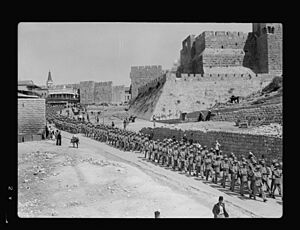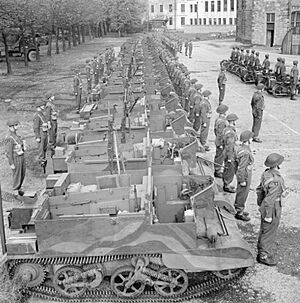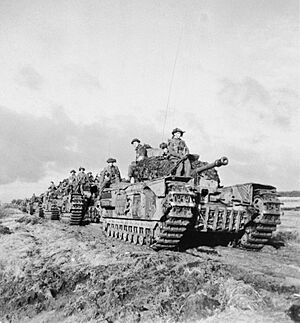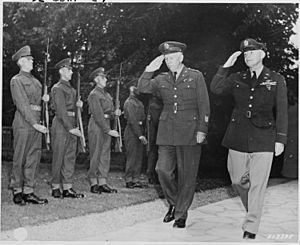History of the Scots Guards (1914–1945) facts for kids
The Scots Guards (often called SG) are a famous part of the British Army. They belong to the Guards Division. Their story began way back in 1642. King Charles I ordered Archibald Campbell, the 1st Marquess of Argyll, to create this regiment. It was first known as the Marquis of Argyll's Royal Regiment and was formed to serve in Ireland. This article tells you about their history from 1914 to 1945, covering their brave actions in two World Wars.
Contents
World War I: The Great War
On June 28, 1914, a very important event happened. Archduke Franz Ferdinand and his wife, Countess Sophie, were killed by a Serbian nationalist. This sad event started what we now call the First World War. By August, most major countries in Europe, including the United Kingdom, were at war. This conflict would change the world forever.
The 3rd (Reserve) Battalion of the Scots Guards was formed again in August 1914. However, they stayed in the UK and did not fight abroad. They were later disbanded in 1919. Also in August, the 1st Battalion, which was part of the 1st Guards Brigade, traveled to France. They were part of the British Expeditionary Force (BEF), which was the main British army sent to fight.
Early Battles and Brave Actions
The Scots Guards' first battle was at Mons. British soldiers fought well against the Germans. They caused heavy losses for the Germans. Even though they fought bravely, the British had to retreat because the German army was much larger. The French army also retreated. This retreat saved the British army and allowed them to keep fighting in France.
In September, the 1st Battalion fought in the First Battle of the Marne. Here, the German advance was stopped after tough fighting. Both sides then started digging trenches. These trenches became a key symbol of the First World War. The battalion also fought hard at the Battle of the Aisne, including at Aisne Heights and Chivy.
In November, the 2nd Battalion arrived in France. They were part of the 20th Guards Brigade. Both battalions then took part in the First Battle of Ypres from September to November. They faced very heavy fighting. Over 50,000 British soldiers were hurt or killed. But the British army held their ground against strong German attacks. They stopped the Germans from breaking the Allied line in 1914.
In December, Private James Mackenzie of the 2nd Battalion showed amazing bravery. He won the regiment's first Victoria Cross (VC) of the war. A VC is the highest award for bravery in the British military. He rescued a badly wounded British soldier from in front of German trenches, under heavy fire. Sadly, Private Mackenzie was killed later that day while trying to help another soldier.
Fighting in 1915 and 1916
In March 1915, the 2nd Battalion fought in the Battle of Neuve Chapelle. This battle was somewhat successful, but they did not reach all their goals. In May, both battalions fought in the Battle of Aubers. Later that month, the 2nd Battalion also fought in the Battle of Festubert.
On August 3, Second Lieutenant George Arthur Boyd-Rochfort of the 1st Battalion showed incredible courage. A trench mortar bomb landed near him and his men. Without thinking about his own safety, he shouted a warning. He then rushed to the bomb, picked it up, and threw it over the wall of the trench. It exploded right away. For his brave actions, Lieutenant Boyd-Rochfort was awarded the Victoria Cross.
Also in August, both battalions joined the new Guards Division. The 1st Battalion joined the 2nd Guards Brigade on August 25. The 2nd Battalion joined the 3rd Guards Brigade on September 9.
In September, both battalions fought in the Battle of Loos. On September 27, the 3rd Guards Brigade (with the 2nd Battalion) was hit by heavy artillery fire. This caused many casualties. The next day, the 2nd Guards Brigade (with the 1st Battalion) attacked a position called Puits 14 bis. They suffered very heavy losses and had to stop their attack. Both battalions continued to fight hard through September and October. By the end of the Battle of Loos, the Scots Guards had lost over 500 men.
The first Battle of the Somme began on July 1, 1916. On that first day, over 57,000 British soldiers were killed or wounded. In September, the Scots Guards joined the Somme Offensive. They fought in the Battle of Flers–Courcelette, where tanks were used for the first time. They also fought at Morval, where they captured Lesboeufs. On July 15, Lance-Sergeant Frederick McNess of the 1st Battalion led a group under heavy fire. He was badly wounded but kept fighting and throwing grenades until he lost too much blood.
Later Years of the War
In July 1917, the regiment began fighting in the Third Battle of Ypres. This battle lasted until November. They took part in many tough fights, including at Pilckem, Menin Road, Poelcapelle, and Passchendaele. The fighting was very severe, and British soldiers faced terrible conditions and heavy losses. In November, the regiment fought in the Battle of Cambrai (1917). This battle is famous for the first large-scale use of British tanks, with 476 tanks in total.
On November 27, Sergeant John McAulay of the 1st Battalion showed great leadership. All his officers were hurt, so he took command of his company. Under heavy fire, he held their position. He then saw a German counter-attack starting. He used machine-guns cleverly to stop the Germans, causing them heavy losses. Sergeant McAulay also carried his badly wounded company commander to safety, even though he was knocked down twice by explosions. For his heroic actions, Sergeant McAulay was awarded the Victoria Cross.
In March 1918, the second Battle of the Somme began. It lasted until April, though fighting in the Somme area continued until September. The regiment fought in battles at St. Quentin, Bapaume, Arras, and Albert. In September, they fought at the Battle of Havrincourt against the strong Hindenburg Line. They also fought at the Battle of the Canal du Nord and, in October, at the Battle of Cambrai (1918).
On October 13, Lance Corporal Harry Blanshard Wood of the 2nd Battalion showed amazing leadership at St. Python. His platoon sergeant was killed, so Corporal Wood took command. They were advancing on the village under heavy fire. A space in front of them was covered by German snipers. Corporal Wood bravely took a large brick, lay behind it, and shot at the snipers. He ordered his men to cross the open space while he covered them. He stayed in the open until all his men were safe. Later that day, Corporal Wood fought off several German counter-attacks. For his brave and professional actions, Corporal Wood was awarded the Victoria Cross. This was the last VC won by the regiment in the First World War.
The Scots Guards took part in the final battles on the Western Front. On October 17, the Battle of the Selle began, leading to the capture of Valenciennes. On November 4, they fought in the Battle of the Sambre. At 11 AM on November 11, the Armistice was signed, ending the war.
The Guards Division, including the Scots Guards, soon moved to the Rhine River in Germany. They crossed the border on December 11. The Scots Guards then joined the British Army of Occupation in Cologne and returned home in 1919. During the First World War, the regiment earned thirty-three battle honors. Sadly, they lost almost 3,000 men.
Between the Wars: A Time of Peace
In 1918, the rank of "Private" in the Foot Guards was changed to "Guardsman." After serving in Germany, the Scots Guards returned home in 1919. They marched in London as part of the Guards Division. Both battalions stayed in the United Kingdom for most of the years between the wars. They performed important public duties, like guarding royal palaces. Sometimes, they were sent abroad.
In 1927, the 2nd Battalion went to Shanghai in the Far East. This was during a conflict between Communists and Nationalists in China. The battalion helped protect British people living in Shanghai. They were also stationed in Hong Kong before returning home in 1929.
In 1933, the regiment formed a special connection with the Winnipeg Grenadiers of Canada. In 1935, the 1st Battalion was sent to Egypt. This was a tense time because Italy had invaded Ethiopia. In 1936, the 2nd Battalion went to Palestine, where there was a lot of violence during the Arab Revolt.
That same year, their connection with the 13th Scottish Light Dragoons of Canada ended when that regiment was disbanded. The Scots Guards also gained two new "Colonel-in-Chiefs." This is a special honorary role, often held by a royal family member. King Edward VIII became their Colonel-in-Chief, and then King George VI took over after King Edward stepped down. In 1938, the 2nd Battalion moved to Egypt, where they were when the Second World War began.
World War II: Global Conflict
On September 1, 1939, Nazi Germany invaded Poland. Two days later, the British Empire, France, and Germany declared war. This started the Second World War.
In April 1940, the 1st Battalion, part of the 24th Guards Brigade, took part in the campaign in Norway. They landed in Harstad on April 16. The 24th Guards Brigade protected Norwegian ports from German attacks. However, all the ports fell by the end of May. Because of the difficult situation in France, the British Army began leaving Norway. The evacuation was finished by June 8. Later that year, the 3rd Battalion was formed again and joined the 30th Infantry Brigade. The 4th Battalion and a Holding Battalion were also created.
North Africa: Desert Battles
In the North African Campaign, the 2nd Battalion, part of the 22nd Guards Brigade, fought against the Italians in Egypt. The next year, they faced tough fighting in Libya, which was controlled by Italy. The regiment fought bravely in many battles.
In May 1941, they saw action at the Battle of Halfaya Pass. British and Commonwealth forces faced strong resistance from Erwin Rommel's Afrika Korps, which was a German and Italian force. In June, the battalion was involved in Operation Battleaxe. This was a British attempt to help the city of Tobruk, which was surrounded by enemy forces. But the enemy was stronger and had better weapons, so the Allies had to retreat.
The next British attack, Operation Crusader, began in November. This was another attempt to break the siege of Tobruk. This time, it worked! It was a very close fight with heavy losses, especially for tanks. The operation ended in December, and the siege of Tobruk was finally lifted. Its defenders, mostly Australians, had held out since April. Back in the United Kingdom, the 3rd Battalion changed its role. It became an armored battalion, renamed the 3rd (Tank) Battalion, and joined the 6th Guards Armoured Brigade.
In early 1942, Rommel's Afrika Korps launched a new attack. This surprised the Allies and forced them to retreat. The German attack stopped in early February at Gazala. Later that year, the battalion joined the 201st Guards Brigade. In May, the Germans attacked again. The 201st Guards Brigade was at a place called Knightsbridge Box. Other British, Commonwealth, and Free French brigades held other "Boxes" that formed the "Gazala Line."
The Guards at Knightbridge fought very hard against the German attackers. By June 13, the Guards were cut off from other Allied forces. A German attack, during bad weather, overran the 2nd Battalion. That night, after an Allied counter-attack, the Guards managed to retreat in an organized way. Soon after, most Allied forces retreated to the "El Alamein Line." Tobruk fell on June 20, and thousands of Allied troops were captured, including men from the 2nd Battalion. Some managed to escape to Egypt. The battalion was then reformed in Egypt.
Between October and November 1942, the Second Battle of El Alamein took place. General Montgomery's British Eighth Army won a huge victory over the Germans. The Germans were forced to retreat completely. By January 1943, the Allied armies had pushed the enemy back significantly, even capturing Tripoli.
Back in the UK, the 3rd Battalion was renamed the 3rd (Tank) Battalion and joined the 6th Guards Tank Brigade. In North Africa, on March 6, the 2nd Battalion fought in the defensive Battle of Medenine. The Germans had counter-attacked, and if they had succeeded, it would have caused many problems for the British. The Scots Guards fought bravely, using their anti-tank guns very effectively against German tanks. Many German tanks were destroyed, and the German attack was soon called off.
That same month, the 1st Battalion arrived in North Africa from the UK as part of the 24th Guards Brigade. Both battalions continued to fight in North Africa. The 1st Battalion saw heavy fighting in April at Medjez Plain and Djebel Bou Aoukaz.
During that month, Captain The Lord Lyell of the 1st Battalion showed great courage and leadership. He commanded his company with great spirit during battles between April 23 and 27. He kept his troops' spirits high during very heavy fighting against German forces. On April 27, Captain The Lord Lyell's company attacked Djebel Bou Aoukaz. They were being held back by an enemy post with a powerful 88 mm gun and a heavy machine-gun. Lord Lyell led an attack on this post with a sergeant, a lance-corporal, and two guardsmen. Lord Lyell went ahead and destroyed the machine-gun crew with a grenade. Three of his party were hurt, while the lance-corporal provided covering fire. Lord Lyell then attacked the 88 mm gun pit with his bayonet and pistol, killing several of the gun crew before being overwhelmed and killed by the remaining crew. The remaining crew then left, and both guns were silenced, allowing the advance to continue. Lord Lyell was awarded the Victoria Cross after his death for his courageous actions and leadership.
Italy and France: New Fronts
By May 1943, the battle for North Africa was over. Tunis had fallen, and the Allies were victorious. 130,000 German and 120,000 Italian soldiers surrendered. In September, the 2nd Battalion, part of the 201st Guards Brigade, took part in the landings at Salerno in Italy. They then faced heavy fighting through September and in October crossed the Volturno River. At the Battle of Monte Cassino, the 2nd Battalion suffered heavy losses in tough fighting. The position was finally captured in May 1944.
In December, the 1st Battalion, part of the 24th Guards Brigade, arrived in Italy. In January 1944, the Scots Guards took part in the landings at Anzio. They saw heavy fighting there, including at Campoleone and Carroceto. The Allies were stuck in the Anzio beachhead for several months. The 1st Battalion joined the 6th South African Armoured Division in May. The regiment fought in many fierce battles throughout 1944, including at Monte San Michele and against the Gothic Line, which was a very strong German defensive line. In 1945, the regiment continued to fight in some bitter battles. In April, they took part in a landing operation in the Bonifica area, east of the Argenta Gap. The 1st Battalion faced heavy fighting and suffered many casualties. In May, the battalion found itself in Trieste, which had been captured by Yugoslavian and Croatian forces. The battalion stayed in Trieste until 1946.
Back in July 1944, the 3rd (Tank) Battalion landed in France. Heavy fighting was still happening in the Normandy area. The battalion saw action at Mont Pincon. At Quarry Hill, a squadron of the battalion was ambushed by three powerful German tank destroyers called Jagdpanthers. These destroyed eleven Churchill tanks of the battalion. However, the Scots Guards eventually forced the Germans to retreat. The battalion continued to advance with the Allies, fighting in the Venlo Pocket in the Netherlands and in the Rhineland in 1945.
In March 1945, the 2nd Battalion arrived in North-West Europe and joined the Guards Armoured Division. The regiment fought deeper inside Germany, including at Lingen and Uelzen. On May 8, after six long years, the war in Europe officially ended. This day is known as Victory in Europe Day. On May 14, the regiment took control of the small German island of Heligoland. In June, the 3rd (Tank) Battalion changed back to an infantry battalion, becoming the 3rd Battalion again, as part of the renamed 6th Guards Brigade.
The 2nd and 3rd Battalions were stationed in Germany. In early 1946, the 3rd Battalion was disbanded in Cologne. The 2nd Battalion returned home to the United Kingdom in December.
Just like in the First World War, the Scots Guards showed their professionalism and bravery once more. They served in North Africa, Italy, and across North-West Europe. They were part of some of the British Army's most famous moments. During the war, just over 1,000 men of the Scots Guards lost their lives. Many awards for bravery were won, including one Victoria Cross.





